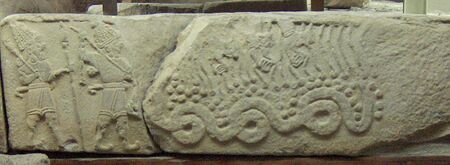Unsolved:Illuyanka

Museum of Anatolian Civilizations, Ankara, Turkey
In Hittite mythology, Illuyanka was a serpentine dragon slain by Tarḫunz (Script error: The function "transl" does not exist.), the Hittite incarnation of the Hurrian god of sky and storm.[1] It is known from Hittite cuneiform tablets found at Çorum-Boğazköy, the former Hittite capital Hattusa. The contest is a ritual of the Hattian spring festival of Puruli.
The myth is found in Catalogue des Textes Hittites 321, which gives two consecutive versions.
Name
- See also Eel § Etymology
Illuyanka is probably a compound, consisting of two words for "snake", Proto-Indo-European *h₁illu- and *h₂eng(w)eh₂-. The same compound members, inverted, appear in Latin anguilla "eel". The *h₁illu- word is cognate to English eel, the anka- word to Sanskrit ahi.[2]
Narrative
In the first version, the two gods fight and Illuyanka wins. Teshub then goes to the Hattian goddess Inaras for advice. Having promised her love to a mortal named Hupasiyas in return for his help, she devises a trap for the dragon. She goes to him with large quantities of food and drink, and entices him to drink his fill. Once drunk, the dragon is bound by Hupasiyas with a rope. Then the Sky God Teshub appears with the other gods and kills the dragon.[3]
In the second version, after the two gods fight and Teshub loses, Illuyanka takes Teshub's eyes and heart. To avenge himself upon the dragon, the Sky God Teshub marries the goddess Hebat, daughter of a mortal, named Arm. They have a son, Sarruma, who grows up and marries the daughter of the dragon Illuyanka. The Sky God Teshub tells his son to ask for the return of Teshub's eyes and heart as a wedding gift, and he does so. His eyes and heart restored, Teshub goes to face the dragon Illuyanka once more. At the point of vanquishing the dragon, Sarruma finds out about the battle and realizes that he had been used for this purpose. He demands that his father take his life along with Illuyanka's, and so Teshub kills them both with thundery rain and lightning.[4] This version is illustrated on a relief which was discovered at Malatya (dating from 1050-850 BC) and is on display in the Museum of Anatolian Civilizations in Ankara, Turkey.[citation needed]
Interpretation
The Hittite texts were introduced in 1930 by W. Porzig, who first made the comparison of Teshub's battle with Illuyankas with the sky-god Zeus' battle with serpent-like Typhon, told in Pseudo-Apollodorus, Bibliotheke (I.6.3);[5] the Hittite-Greek parallels found few adherents at the time, the Hittite myth of the castration of the god of heaven by Kumarbi, with its clearer parallels to Greek myth, not having yet been deciphered and edited.
Manuscripts
Catalogue des Textes Hittites 321 consists of the following tablets:
- A. KBo III 7
- B. KUB XVII 5
- C. KUB XVII 6
- D. KUB XII 66
- E. KUB XXXVI 54
- F. KBo XII 83
- G. KBo XII 84, XIII 84
- H. KBo XXII 99
- J. KUB XXXVI 53
None of the individual versions is complete. Text A is the most complete, including 30 out of 36 paragraphs.[6]
See also
- Hittite mythology
- Hurrian mythology
- List of dragons in mythology and folklore
- Lotan, Ugarit sea serpent
- Jörmungandr, 'world serpent' in Norse myth
- Nidhögg, a dragon that gnaws at the world tree in Norse myth
- Tiamat, the chaos-dragon of Mesopotamia
- Typhon, giant snake in Greek myth
- Vritra, dragon personifying drought in Vedic religion
- Yamata no Orochi, eight headed and eight tailed dragon in Japanese legend
References
- ↑ Leick, Gwendolyn (1998). A Dictionary of Ancient Near Eastern Mythology. London, England: Psychology Press. pp. 85. ISBN 9780415198110. https://books.google.com/books?id=CeEZD-9L5ogC&source=gbs_navlinks_s.
- ↑ Katz, Joshua T. (1998), Jasanoff; Melchert; Oliver, eds., "How to be a Dragon in Indo-European: Hittite Illuyankas and its Linguistic and Cultural Congeners in Latin, Greek, and Germanic", Mír Curad. Studies in Honor of Calvert Watkins: pp. 317–334
- ↑ Beckman, Gary (1982), "The Anatolian Myth of Illuyanka", Journal of the Ancient Near Eastern Society 14: 11–25, https://deepblue.lib.umich.edu/handle/2027.42/77487
- ↑ Beckman, Gary (1982), "The Anatolian Myth of Illuyanka", Journal of the Ancient Near Eastern Society 14: 11–25, https://deepblue.lib.umich.edu/handle/2027.42/77487
- ↑ Porzig, W. (1930), "Illuyankas und Typhon", Kleinasiatische Forschung (I.3): pp. 379–86
- ↑ Beckman, Gary (1982), "The Anatolian Myth of Illuyanka", Journal of the Ancient Near Eastern Society 14: 11–25, https://deepblue.lib.umich.edu/handle/2027.42/77487

